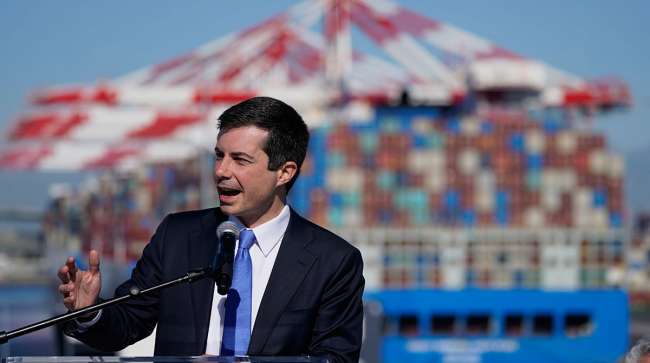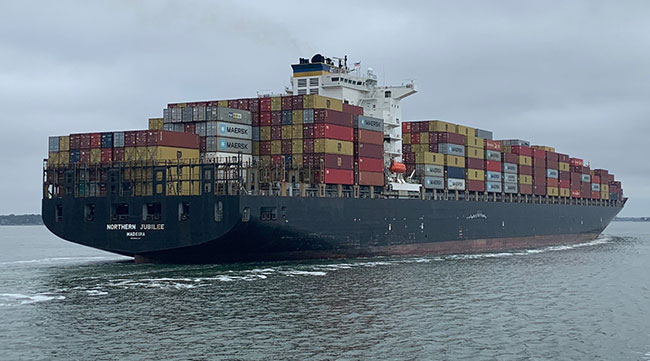Senior Reporter
Ports to Get $450 Million to Speed Flow of Goods

[Stay on top of transportation news: Get TTNews in your inbox.]
As cargo volumes continued to surge at the nation’s ports in January, the Biden administration on Feb. 23 announced plans to make $450 million available in new grant funding as part of the Department of Transportation’s Port Infrastructure Development Program.
Administration officials said the funding is the largest investment in this program in history, and the money will help improve the movement of goods through the ports.
“We’re proud to announce this funding to help ports improve their infrastructure — to get goods moving more efficiently and help keep costs under control for American families,” Transportation Secretary Pete Buttigieg said in a statement. “President Biden is leading the largest ever federal investment in modernizing our country’s ports, which will improve our supply chains and the lives of Americans who depend on them.”
Today, President Biden & @USDOT announced $450 million of Bipartisan Infrastructure Law funding for ports across the country to make upgrades, from constructing new berths to restoring docks to extending rail lines. @POTUS is #BuildingABetterAmerica by modernizing our ports. — Mitch Landrieu (@MitchLandrieu46) February 23, 2022
The new infrastructure law calls for spending $17 billion over the next several years to upgrade ports.
The PIDP grants will be awarded on a competitive basis.
Meanwhile, January was a strong month.
Led by a surge of imports, the nation’s busiest port, Los Angeles, processed 865,595 20-foot-equivalent unit containers. That’s a 3.6% increase over the same month a year ago, when workers moved 835,516 TEUs. It’s also a record for January.
The Port of Long Beach also had a record January, moving 4.8% more containers than a year ago. All told, 800,943 TEUs were processed compared with 764,006 in 2021.

Cordero
“We expect to remain moderately busy into the spring as we make significant progress to clear the docks and process the backlog of vessels waiting off shore,” Port of Long Beach Executive Director Mario Cordero said.
Los Angeles and Long Beach have delayed again the proposed container dwell time fee, designed to help remove aging cargo. Since the fee was announced Oct. 25, there has been a 68% reduction in cargo that sits too long on the docks.
The Port of Oakland processed 193,205 containers in January, and the 2022 volume is down 2.9% from 199,098 in 2021. However, imported cargo surged with 83,860 TEUs, up 8.3% more than last year.
According to the port, strong U.S. consumer spending continues to spur the import binge.

Brandes
“As imports rise nationwide, Oakland continues to play a key role in strengthening the global supply chain,” Port of Oakland Maritime Director Bryan Brandes said. “We’re also working closely with federal, state and industry partners to boost exports that include agricultural commodities.”
The Northwest Seaport Alliance, which operates the ports in Seattle and Tacoma, Wash., reported a 5.8% year-over-year decline, processing 272,281 TEUs in January compared with 289,187 a year ago. Port officials attributed that to a 36% drop in export cargo.
In the Gulf Coast, year-over-year container volume at Port Houston surged 27% as the facility processed 323,427 containers in January compared with 255,039 in 2021.
On Feb. 10, the port took delivery of three new Neopanamax STS cranes, capable of processing cargo from the biggest ships now stopping at Houston. The cranes will be operational later this year.
Our 3 new STS cranes have arrived! M/V Zhen Hua 25 delivered 3 new Neopanamax #STScranes to our #Bayport Container Terminal. These cranes will be our largest to date standing 40 stories tall with boom fully raised and outreach 186.5 feet across. https://t.co/WHb0oQLtTD pic.twitter.com/xVRfZEZ1PH — Port Houston (@Port_Houston) February 10, 2022
On the East Coast, Port of Savannah, which finished a record-setting 2021 by processing more than 5.6 million TEUs, started 2022 with another record.
The port moved 476,713 TEUs, besting by 4% last January’s 459,608. The facility has set monthly records for the past 18 months.
“The steps we have taken to add capacity have broken the logjam in global logistics for our customers and created jobs throughout the supply chain” Georgia Ports Authority Executive Director Griff Lynch said.
According to a University of Georgia-Terry College of Business School study, the increase in volume at the port added 93,000 jobs to the state’s economy in 2021.
The Port of Virginia saw a 3.3% year-over-year decline to 262,020 containers compared with 270,969. Meanwhile, a study by the College of William and Mary showed in fiscal 2021 the port contributed $47 billion to Virginia’s gross state product, a $9.4 billion increase from fiscal 2018, the last time a similar survey was conducted.

A containership leaves the Port of Charleston, S.C. (Judd Hanson/Transport Topics)
South Carolina Ports Authority said January set a record for container volume as it processed 226,515 TEUs compared with 216,265 a year ago. That marked the 11th consecutive month of year-over-year container records.
“The global supply chain continues to see great strain from handling unprecedented amounts of cargo,” said Jim Newsome, CEO of SCPA. “With record throughput volumes, we are experiencing a record number of import containers on our terminals awaiting delivery.”
The Port Authority of New York and New Jersey and the Port of Baltimore did not have container numbers available at press time.
Want more news? Listen to today's daily briefing below or go here for more info:




